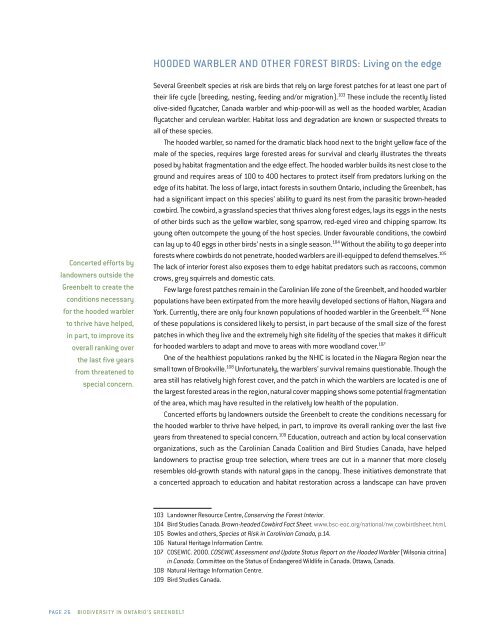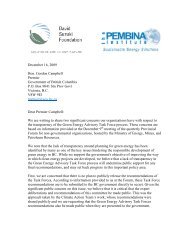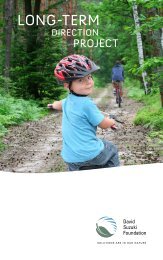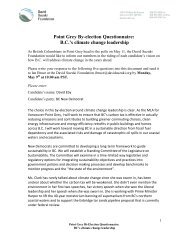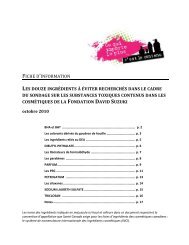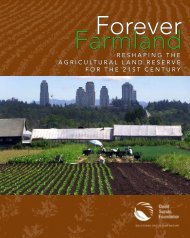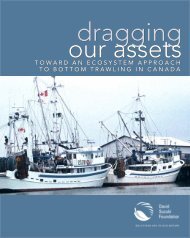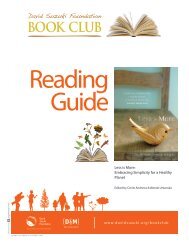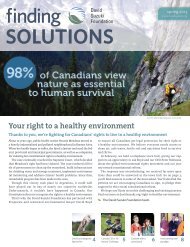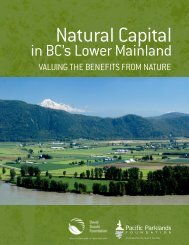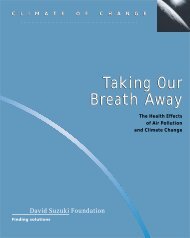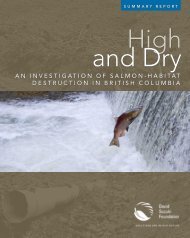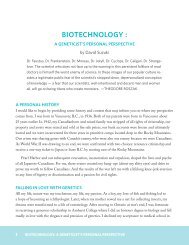Biodiversity in Ontario's Greenbelt (PDF) - David Suzuki Foundation
Biodiversity in Ontario's Greenbelt (PDF) - David Suzuki Foundation
Biodiversity in Ontario's Greenbelt (PDF) - David Suzuki Foundation
Create successful ePaper yourself
Turn your PDF publications into a flip-book with our unique Google optimized e-Paper software.
Hooded warbler and other forest birds: Liv<strong>in</strong>g on the edge<br />
Concerted efforts by<br />
landowners outside the<br />
<strong>Greenbelt</strong> to create the<br />
conditions necessary<br />
for the hooded warbler<br />
to thrive have helped,<br />
<strong>in</strong> part, to improve its<br />
overall rank<strong>in</strong>g over<br />
the last five years<br />
from threatened to<br />
special concern.<br />
Several <strong>Greenbelt</strong> species at risk are birds that rely on large forest patches for at least one part of<br />
their life cycle (breed<strong>in</strong>g, nest<strong>in</strong>g, feed<strong>in</strong>g and/or migration). 103 These <strong>in</strong>clude the recently listed<br />
olive-sided flycatcher, Canada warbler and whip-poor-will as well as the hooded warbler, Acadian<br />
flycatcher and cerulean warbler. Habitat loss and degradation are known or suspected threats to<br />
all of these species.<br />
The hooded warbler, so named for the dramatic black hood next to the bright yellow face of the<br />
male of the species, requires large forested areas for survival and clearly illustrates the threats<br />
posed by habitat fragmentation and the edge effect. The hooded warbler builds its nest close to the<br />
ground and requires areas of 100 to 400 hectares to protect itself from predators lurk<strong>in</strong>g on the<br />
edge of its habitat. The loss of large, <strong>in</strong>tact forests <strong>in</strong> southern Ontario, <strong>in</strong>clud<strong>in</strong>g the <strong>Greenbelt</strong>, has<br />
had a significant impact on this species’ ability to guard its nest from the parasitic brown-headed<br />
cowbird. The cowbird, a grassland species that thrives along forest edges, lays its eggs <strong>in</strong> the nests<br />
of other birds such as the yellow warbler, song sparrow, red-eyed vireo and chipp<strong>in</strong>g sparrow. Its<br />
young often outcompete the young of the host species. Under favourable conditions, the cowbird<br />
can lay up to 40 eggs <strong>in</strong> other birds’ nests <strong>in</strong> a s<strong>in</strong>gle season. 104 Without the ability to go deeper <strong>in</strong>to<br />
forests where cowbirds do not penetrate, hooded warblers are ill-equipped to defend themselves. 105<br />
The lack of <strong>in</strong>terior forest also exposes them to edge habitat predators such as raccoons, common<br />
crows, grey squirrels and domestic cats.<br />
Few large forest patches rema<strong>in</strong> <strong>in</strong> the Carol<strong>in</strong>ian life zone of the <strong>Greenbelt</strong>, and hooded warbler<br />
populations have been extirpated from the more heavily developed sections of Halton, Niagara and<br />
York. Currently, there are only four known populations of hooded warbler <strong>in</strong> the <strong>Greenbelt</strong>. 106 None<br />
of these populations is considered likely to persist, <strong>in</strong> part because of the small size of the forest<br />
patches <strong>in</strong> which they live and the extremely high site fidelity of the species that makes it difficult<br />
for hooded warblers to adapt and move to areas with more woodland cover. 107<br />
One of the healthiest populations ranked by the NHIC is located <strong>in</strong> the Niagara Region near the<br />
small town of Brookville. 108 Unfortunately, the warblers’ survival rema<strong>in</strong>s questionable. Though the<br />
area still has relatively high forest cover, and the patch <strong>in</strong> which the warblers are located is one of<br />
the largest forested areas <strong>in</strong> the region, natural cover mapp<strong>in</strong>g shows some potential fragmentation<br />
of the area, which may have resulted <strong>in</strong> the relatively low health of the population.<br />
Concerted efforts by landowners outside the <strong>Greenbelt</strong> to create the conditions necessary for<br />
the hooded warbler to thrive have helped, <strong>in</strong> part, to improve its overall rank<strong>in</strong>g over the last five<br />
years from threatened to special concern. 109 Education, outreach and action by local conservation<br />
organizations, such as the Carol<strong>in</strong>ian Canada Coalition and Bird Studies Canada, have helped<br />
landowners to practise group tree selection, where trees are cut <strong>in</strong> a manner that more closely<br />
resembles old-growth stands with natural gaps <strong>in</strong> the canopy. These <strong>in</strong>itiatives demonstrate that<br />
a concerted approach to education and habitat restoration across a landscape can have proven<br />
103 Landowner Resource Centre, Conserv<strong>in</strong>g the Forest Interior.<br />
104 Bird Studies Canada. Brown-headed Cowbird Fact Sheet. www.bsc-eoc.org/national/nw_cowbirdsheet.html.<br />
105 Bowles and others, Species at Risk <strong>in</strong> Carol<strong>in</strong>ian Canada, p.14.<br />
106 Natural Heritage Information Centre.<br />
107 COSEWIC. 2000. COSEWIC Assessment and Update Status Report on the Hooded Warbler (Wilsonia citr<strong>in</strong>a)<br />
<strong>in</strong> Canada. Committee on the Status of Endangered Wildlife <strong>in</strong> Canada. Ottawa, Canada.<br />
108 Natural Heritage Information Centre.<br />
109 Bird Studies Canada.<br />
Page 26<br />
<strong>Biodiversity</strong> <strong>in</strong> Ontario’s greenbelt


